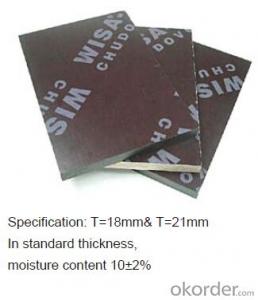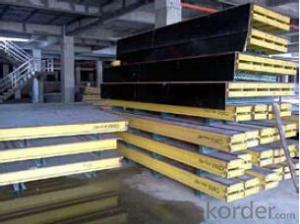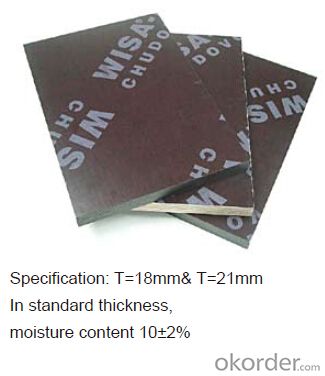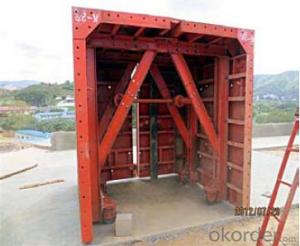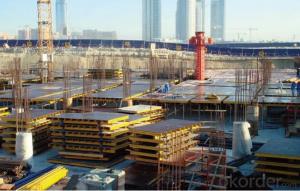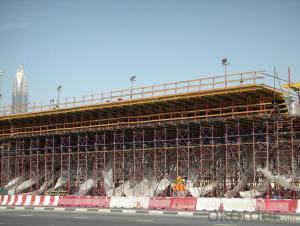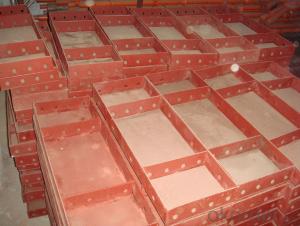Plywood Formwork system for Formwork and Scaffolding
- Loading Port:
- Tianjin
- Payment Terms:
- TT OR LC
- Min Order Qty:
- 50 g/m²
- Supply Capability:
- 1000 g/m²/month
OKorder Service Pledge
Quality Product, Order Online Tracking, Timely Delivery
OKorder Financial Service
Credit Rating, Credit Services, Credit Purchasing
You Might Also Like
Plywood --- make perfect concrete surface
WISA-Form Birch is a coated special plywood using in the formwork systems where high
requirements are set on the concrete surface and the times of reuses.
With CNBM timber beam & WISA plywood, the formwork is low weight but high load capacity, it is
widely used in construction.
Characteristics:
◆ Component with high standardization.
◆ Assembling in site, flexible application.
◆ Light weight, easy transportation and storage.
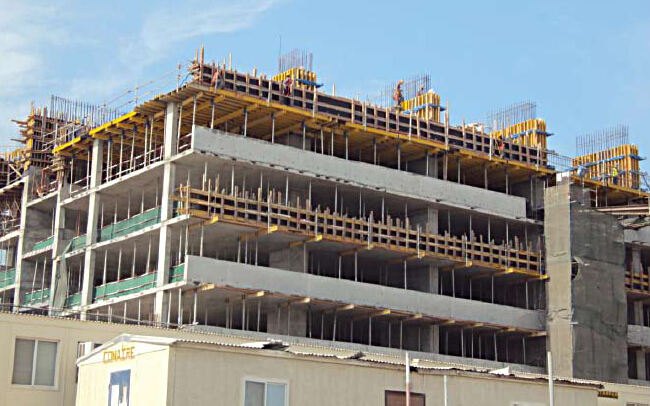
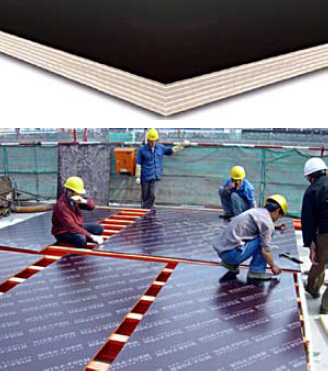
- Q: Can steel formwork be used for dam construction?
- Indeed, dam construction can make effective use of steel formwork. This adaptable and long-lasting alternative is widely employed in a range of construction endeavors, including dams. It boasts various benefits, such as exceptional strength, stiffness, and the capacity to endure the immense pressure and weight of concrete utilized in dam construction. The assembly and disassembly of steel formwork are straightforward, enabling efficient and rapid construction. Moreover, it yields a sleek and consistent surface to the concrete, guaranteeing the durability and longevity of the dam's structure.
- Q: How long does steel formwork last?
- Steel formwork can last for a significantly long time, typically ranging from 10 to 20 years or more, depending on various factors such as maintenance, usage frequency, and quality of the steel.
- Q: What are the different types of joints used in steel formwork construction?
- There are various types of joints commonly utilized in steel formwork construction, each playing a vital role in ensuring the stability and strength of the system. 1. Butt Joint: This uncomplicated joint involves connecting two members in a straight line, end to end. It is frequently employed in formwork construction to connect steel beams or columns. 2. Lap Joint: In this type of joint, two members overlap and are secured together using bolts or welding. Lap joints are commonly used in steel formwork construction to join horizontal and vertical members, such as formwork panels. 3. T-Joint: As the name implies, a T-joint is created by joining two members at right angles. This joint is commonly used to connect steel bracing members, forming a stable framework for the formwork system. 4. Corner Joint: This joint is utilized to connect two members meeting at a 90-degree angle, ensuring proper alignment and stability of the formwork system. 5. Splice Joint: A splice joint joins two steel members end to end, creating a continuous length. This type of joint is commonly used when longer lengths of steel beams or columns are required in formwork construction. 6. Flange Joint: Flange joints connect two steel members with flanges, such as I-beams or channels. The flanges are bolted together, creating a robust and rigid connection. This joint is often used to connect horizontal beams or columns in formwork construction. Choosing the appropriate joint type is crucial in steel formwork construction, as it depends on specific project requirements such as load-bearing capacity, structural stability, and the type of connections needed for the formwork system.
- Q: Can steel formwork be used for bridge piers?
- Yes, steel formwork can be used for bridge piers. It offers high strength, durability, and flexibility, making it suitable for constructing bridge piers that require a sturdy and reliable structure. Additionally, steel formwork allows for easy customization and reusability, making it a cost-effective and efficient choice for bridge pier construction.
- Q: Are all steel plates used for beam slab prefabrication
- Should be determined according to the shape of the prefabricated components, specifications, to facilitate construction, cost savings, to ensure the quality of the premise.
- Q: What are the different types of connectors used with steel formwork?
- To ensure stability and proper alignment, steel formwork can utilize various types of connectors. These connectors are designed to securely join the formwork components and establish a reliable connection. 1. Wedge connectors, commonly employed, consist of a wedge-shaped piece that fits into a slot or hole in the formwork. By tightening the wedge, a strong and secure connection is created. Due to their ease of installation and removal, wedge connectors are favored in steel formwork systems. 2. Pin connectors are typically used to connect two formwork panels together. They involve inserting a pin through holes in the formwork panels and securing it with a locking mechanism. Pin connectors are straightforward and effective, providing stability between panels. 3. Bolt connectors are suitable for heavy-duty and permanent connections. These connectors require bolts to be inserted through pre-drilled holes in the formwork components and tightened with nuts. Bolt connectors offer high strength and stability, making them ideal for larger formwork systems or when dealing with heavier loads. 4. Clamp connectors join formwork components by clamping them with a fastening mechanism. These connectors usually consist of metal plates or brackets that are tightened around the formwork components, ensuring a secure connection. Clamp connectors are versatile and can be used in various formwork applications. 5. Magnetic connectors, a newer type of connector, utilize magnets to join formwork components. Typically made of steel, these connectors contain strong magnets that attract to each other, creating a secure connection. Magnetic connectors are easy to install and remove, eliminating the need for additional tools or fasteners. Overall, the choice of connector for steel formwork depends on project-specific requirements, such as formwork system size, complexity, load-bearing capacity, and desired ease of installation and removal. It is crucial to select connectors that are compatible with the formwork components and provide the necessary strength and stability for the construction process.
- Q: How is steel formwork manufactured?
- Steel formwork is manufactured by cutting and shaping steel plates and bars according to the required dimensions and designs. These steel components are then welded together to form the desired formwork panels, beams, and columns. The steel formwork is further reinforced with additional steel bars and mesh, and the surfaces are treated to resist corrosion. Finally, the formwork is assembled and prepared for use in construction projects.
- Q: How does steel formwork handle formwork stripping time?
- Steel formwork is known for its durability and strength, which allows for efficient and quick formwork stripping. Unlike other materials like wood or plastic, steel formwork does not deform or warp under pressure, ensuring that it can be removed easily and without any damage to the concrete structure. Additionally, steel formwork systems are designed with quick-release mechanisms and adjustable components, allowing for faster and more straightforward formwork stripping. Overall, steel formwork significantly reduces formwork stripping time and increases productivity in construction projects.
- Q: Can steel formwork be used for school construction projects?
- Yes, steel formwork can be used for school construction projects. Steel formwork offers durability, strength, and stability, making it suitable for various construction applications, including school buildings. It provides a reusable and efficient solution for creating concrete structures, allowing for faster construction and cost savings. Additionally, steel formwork can be easily customized to meet specific design requirements and offers a high level of quality and precision in construction projects.
- Q: How does steel formwork contribute to the overall constructability of complex structures?
- In enhancing the overall constructability of complex structures, steel formwork plays a crucial role through various means. Firstly, it provides exceptional strength and durability, enabling it to withstand the heavy loads and pressures exerted during construction. This sturdiness ensures the stability and safety of the structure, minimizing the risk of collapse or failure. Furthermore, steel formwork offers immense flexibility and versatility in shaping different architectural elements, allowing for the construction of intricate and complex designs. Its ability to be easily customized and adjusted facilitates the creation of unique and aesthetically pleasing structures. Moreover, compared to traditional formwork systems, steel formwork enhances construction efficiency by enabling faster assembly and disassembly. The ease of installation and removal reduces construction time, resulting in significant cost savings and increased productivity. Additionally, the reusable nature of steel formwork allows for multiple applications, making it a cost-effective choice in the long run. In addition, steel formwork is highly resistant to moisture, chemicals, and extreme weather conditions, ensuring its longevity and minimizing maintenance requirements. This durability makes it particularly suitable for complex structures where long-term reliability is essential. Overall, steel formwork contributes to the overall constructability of complex structures by providing strength, flexibility, efficiency, and durability. Its ability to withstand heavy loads, create intricate designs, and expedite the construction process makes it an invaluable tool in successfully realizing complex architectural projects.
Send your message to us
Plywood Formwork system for Formwork and Scaffolding
- Loading Port:
- Tianjin
- Payment Terms:
- TT OR LC
- Min Order Qty:
- 50 g/m²
- Supply Capability:
- 1000 g/m²/month
OKorder Service Pledge
Quality Product, Order Online Tracking, Timely Delivery
OKorder Financial Service
Credit Rating, Credit Services, Credit Purchasing
Similar products
Hot products
Hot Searches
Related keywords
